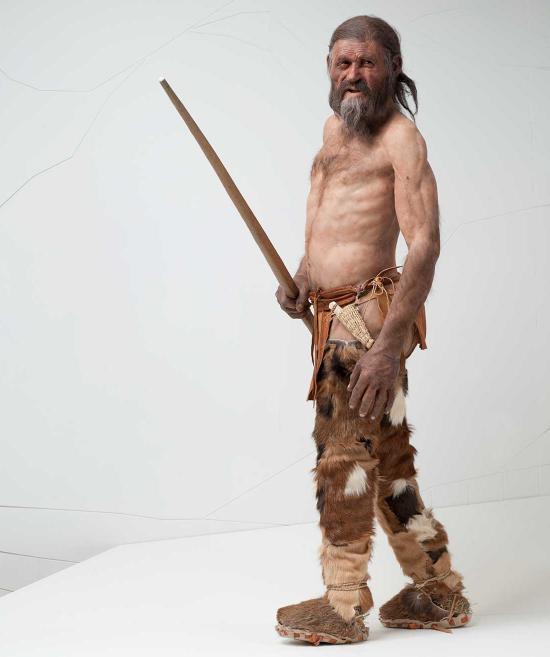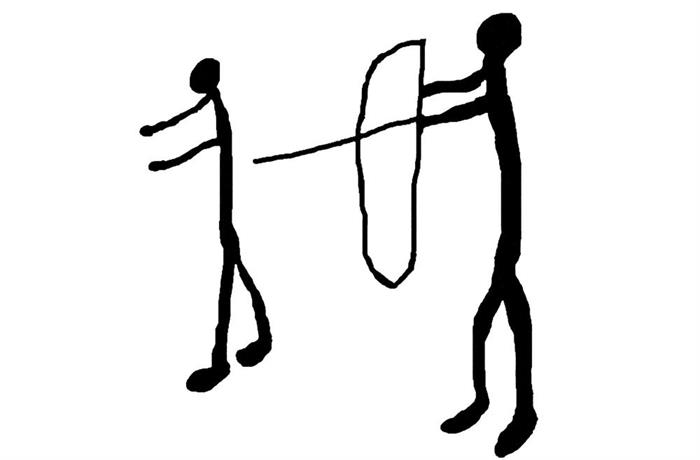Chi è Ötzi? // Who is Ötzi?
Ötzi, l’Uomo del Similaun, è la mummia più vecchia del mondo che si è conservata fino a oggi. Nel settembre 1991 i coniugi Simon hanno scoperto il corpo di Ötzi rilasciato dal ghiaccio in quei giorni durante un’escursione glaciale al Giogo di Tisa nelle Alpi Venoste. Il Giogo di Tisa si trova a soli 16 km in linea d’aria da Laces e dal luogo di ritrovamento del menhir di Laces. Ben presto è diventato chiaro che la mummia risale all’età del rame più di 5000 anni fa. Ci sono tanti reperti da scavi dell’età del rame che includono resti di ossa umane. Questo ritrovamento archeologico però è così sensazionale per i molti resti organici conservati naturalmente nel ghiaccio che di solito si decompongono molto velocemente. Oltre al suo corpo anche l’abbigliamento e i molti oggetti ed utensili di Ötzi danno informazioni interessanti sul passato. Oggi sappiamo che Ötzi visse tra il 3350 e il 3100 a. C. La mummia con tutti i suoi indumenti e l’equipaggiamento è esposta nel Museo Archeologico dell’Alto Adige a Bolzano dove può essere visitata.
Ötzi the Iceman is the oldest preserved mummy of the world. In September 1991, the Simon couple found Ötzi’s corpse, which had just been released by the ice in those days, during a glacier hike at Giogo di Tisa in the Ötztal Alps. Giogo di Tisa is situated at only a 16 km linear distance away from Laces and the site of the find of the Laces menhir. It soon became clear that the corpse was a more than 5,000-year old mummy from the Copper Age. There are many finds from excavations dating back to the Copper Age, including skeletal remains of humans. But this find was so sensational because of the many organic remains that normally decompose very fast and had been preserved in the ice. In addition to Ötzi’s body, his clothing and the many objects and artifacts provide an exciting insight into the past. Today we know that Ötzi lived between 3,350 and 3,100 BC. The mummy is exhibited in the South Tyrol Museum of Archaeology in Bolzano together with his clothing and equipment and can be visited there.

Ötzi, l’uomo del Similaun // Ötzi, the Iceman
Ötzi proveniva dall’insediamento di Laces? // Was Ötzi from Laces?
salito sul passo da nord o da sud. I materiali vegetali degli oggetti ed utensili che Ötzi aveva con sé nonché i resti nello stomaco dimostrano che Ötzi viveva a sud e non a nord della cresta principale delle Alpi. Il corniolo, per esempio, il cui legno fu usato per le sue frecce, cresce molto più spesso a sud che a nord della cresta principale delle Alpi. Il suo luogo di provenienza è stato ulteriormente delimitato. Un’analisi dello smalto dei denti ha infatti evidenziato che non ha passato la sua infanzia in un territorio calcareo, ma in uno cristallino e quindi forse in Val Venosta o Valle Isarco. I minerali nell’acqua potabile si depositano nello smalto e possono dare informazioni sull'habitat. Grazie alla vicinanza del luogo di ritrovamento della mummia si può ipotizzare che Ötzi abbia trascorso almeno parte della sua vita in Val Venosta. Ci sono diverse tracce di insediamenti dell’età del rame nei dintorni. L’archeologo provinciale Dr. Hubert Steiner però assume che Ötzi forse proveniva dall’insediamento di Laces (link: Laces nell’età del rame). „Soprattutto l’analisi dei resti di carbone vegetale dell’insediamento di Laces nonché la ricostruzione della flora nelle vicinanze permettono un confronto con l’uomo del ghiaccio. Si può inoltre fare un confronto con i reperti di cereali. L’insediamento di Laces è il primo insediamento confermato nel fondovalle venostano. Per il resto si tratta sempre di reperti sporadici (Ganglegg e Kalvarienberg, Collina di Tarces, Laudes-Oberberg, Marchriese, Oris, Lasa, Corces-S. Lorenzo, Castel Colsano, Castel Juval). A causa della coincidenza temporale possiamo assumere che Ötzi abbia conosciuto l’insediamento di Laces e che lo abbia passato attraversando la Val Venosta.“
The way across Giogo di Tisa connects the valleys to the north and south of the main Alpine ridge. Ötzi can only have climbed the pass from the north or from the south. The plant materials of the objects and artifacts that Ötzi carried with him as well as the remains in his stomach demonstrate that he lived to the south and not to the north of the main Alpine ridge. Cornelian cherries, for example, whose wood was used to produce his arrows, grow much more often to the south than to the north of the main Alpine ridge. His place of origin could be further delimited. An analysis of his enamel showed that he had spent his childhood on a crystalline area rather than on a chalky area and therefore maybe in Val Venosta or in Valle Isarco. Minerals from the drinking water build up in the enamel and can provide information about the habitat. Due to the proximity of Ötzi’s site of the find it’s just a small step to assume that Ötzi spent at least part of his life in Val Venosta. There are several settlement traces from the Copper Age in the surroundings. The provincial archeologist Dr. Hubert Steiner, however, supposes that Ötzi might have been from the Laces settlement (link: Laces in the Copper Age). „Especially the examination of the charcoal remains from the settlement in Laces can draw a comparison with the Iceman in addition to a reconstruction of the flora in the near surroundings. Another comparison can be made with the cereal finds. The settlement in Laces is the first confirmed settlement in Val Venosta’s valley floor. All others were single finds (Ganglegg and Kalvarienberg, Tarces Hill, Laudes-Oberberg, Marchriese, Oris, Lasa, Corces-St. Laurentius, Colsano Castle, Juval Castle). Given the coincidence in time, we can assume that Ötzi the Iceman at least knew the settlement in Laces. He must have passed the settlement in Laces when he crossed Val Venosta.“
Il menhir di Laces rappresenta l’equipaggiamento di Ötzi? // Is Ötzi’s equipment depicted on the Laces menhir?
Alcuni oggetti che Ötzi aveva con sé assomigliano molto ai motivi rappresentati sul menhir di Laces, cioè ascia, pugnale, arco e frecce. Quest‘equipaggiamento fa parte del repertorio dei motivi dei menhir del gruppo della Val d’Adige. Probabilmente questi oggetti non avevano soltanto un’utilità pratica, ma erano anche simboli per uno stato speciale, potere o virilità.
There is a striking similarity of the objects that Ötzi carried with him and the motifs depicted on the Laces menhir, namely axe, dagger, bow and arrow. This equipment is part of the motif repertoire of the menhirs of the Adige Valley group. These objects might not only have had a practical benefit but might also have been symbols of a special status, power or virility.
Il menhir di Laces rappresenta l’omicidio di Ötzi? // Is Ötzi’s murder depicted on the Laces menhir?
Nel 2001, e quindi dieci anni dopo la scoperta della mummia dell’Uomo del Similaun, sono stati eseguiti ulteriori esami. Un team guidato dal radiologo Dr. Paul Gostner e dal patologo Dr. Egarter Vigl ha preso in esame la mummia con un apparecchio radiologico e ha scoperto qualcosa di veramente sorprendente: Nella spalla sinistra di Ötzi c’era una punta di freccia! Nessun scienziato prima di loro ha visto l'evidente. La punta di freccia di selce è lunga 27mm e larga 18mm. Non è stata rimossa dagli scienziati e quindi si trova ancora nel corpo dell’Uomo del Similaun. Ötzi fu ferito da una freccia. È stato assassinato? Sul lato posteriore del menhir di Laces si trova un motivo molto particolare e misterioso: un arciere punta la sua freccia verso un’altra persona. È la storia di Ötzi?
In 2001, and thus ten years after the Iceman’s discovery, Ötzi’s mummy underwent further examinations. A team around radiologist Dr. Paul Gostner and pathologist Dr. Egarter Vigl scrutinized the mummy with an X-ray unit and discovered something amazing: They found an arrowhead in his left shoulder! No scientist before them had seen the obvious. The arrowhead of flint is 27mm long and 18mm wide. It wasn’t removed by the scientists and can still be seen in Ötzi’s body. Ötzi was hit by an arrow. Was he murdered? There is a very special, mysterious motif on the backside of the Laces menhir: A bowman points his arrow at another person. Is this Ötzi’s story?

Figura con arco tirato // Figure with drawn bow